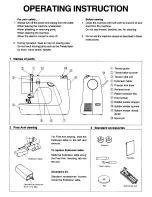
41
RELATIONSHIP BETWEEN TAKE-UP LEVER AND HOOK
The following pictures show the location of hook when the take-up lever starts to move up from the lower
dead stop (main shaft rotation angle: 295°).
Too
small
When the hook timing falls in the A range (see
illustration below) the loop will be too small. Stitch
formation will take place faster than the upward
movement of the take-up lever. The thread will be
too loose and looping and skipped stitches will
occur.
If the hook timing falls in the B range (see below),
the hook point will catch the thread when the loop is
too big. This will cause thread breaks since the
upward movement of the take-up lever is faster then
the rate at which the thread comes off the hook.
(B)
(C)
(A)
CAUTION
When the hook timing is correct, the
hook should move within the C range.
In case of fast hook timing
In case of slow hook timing
















































